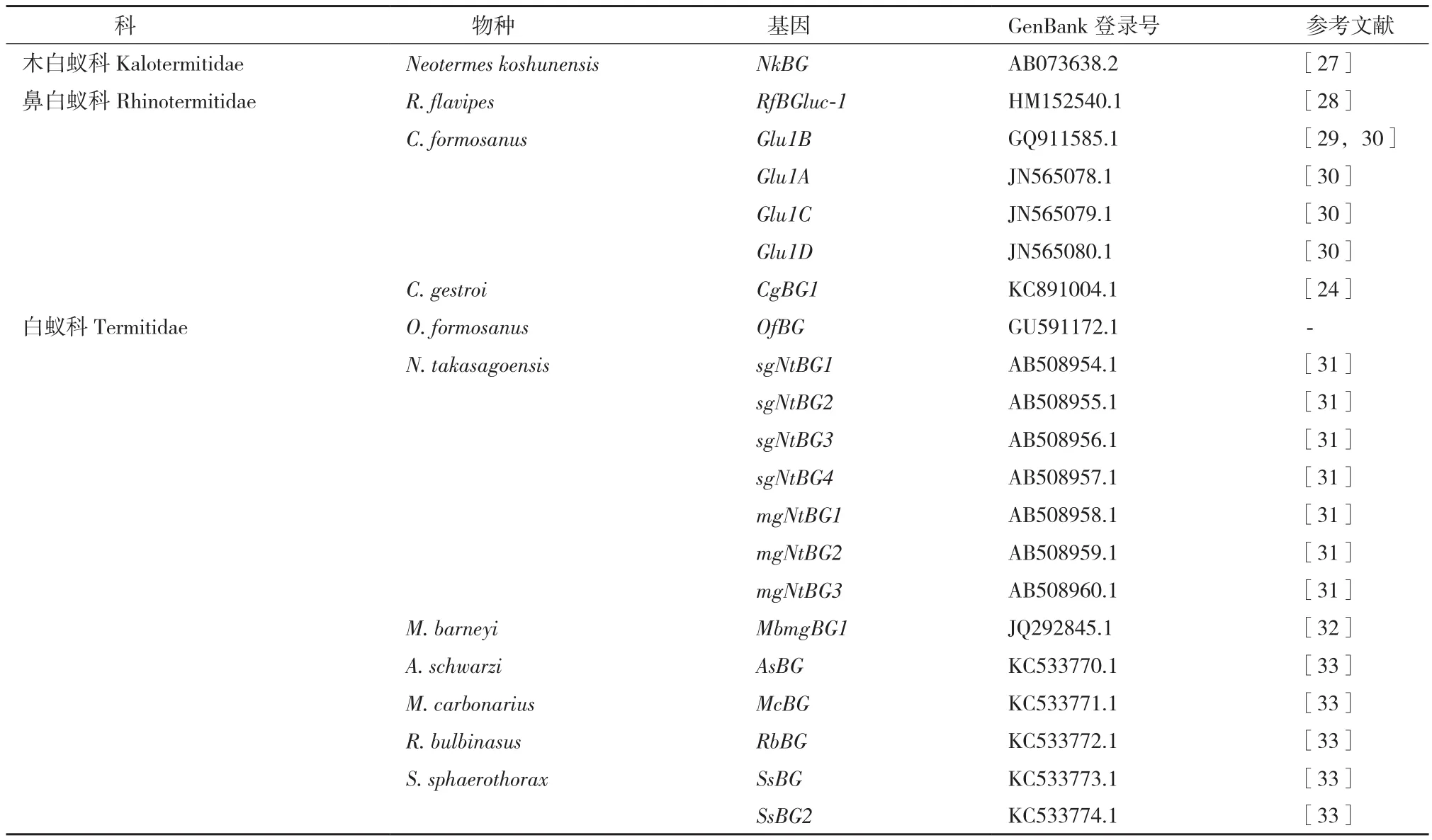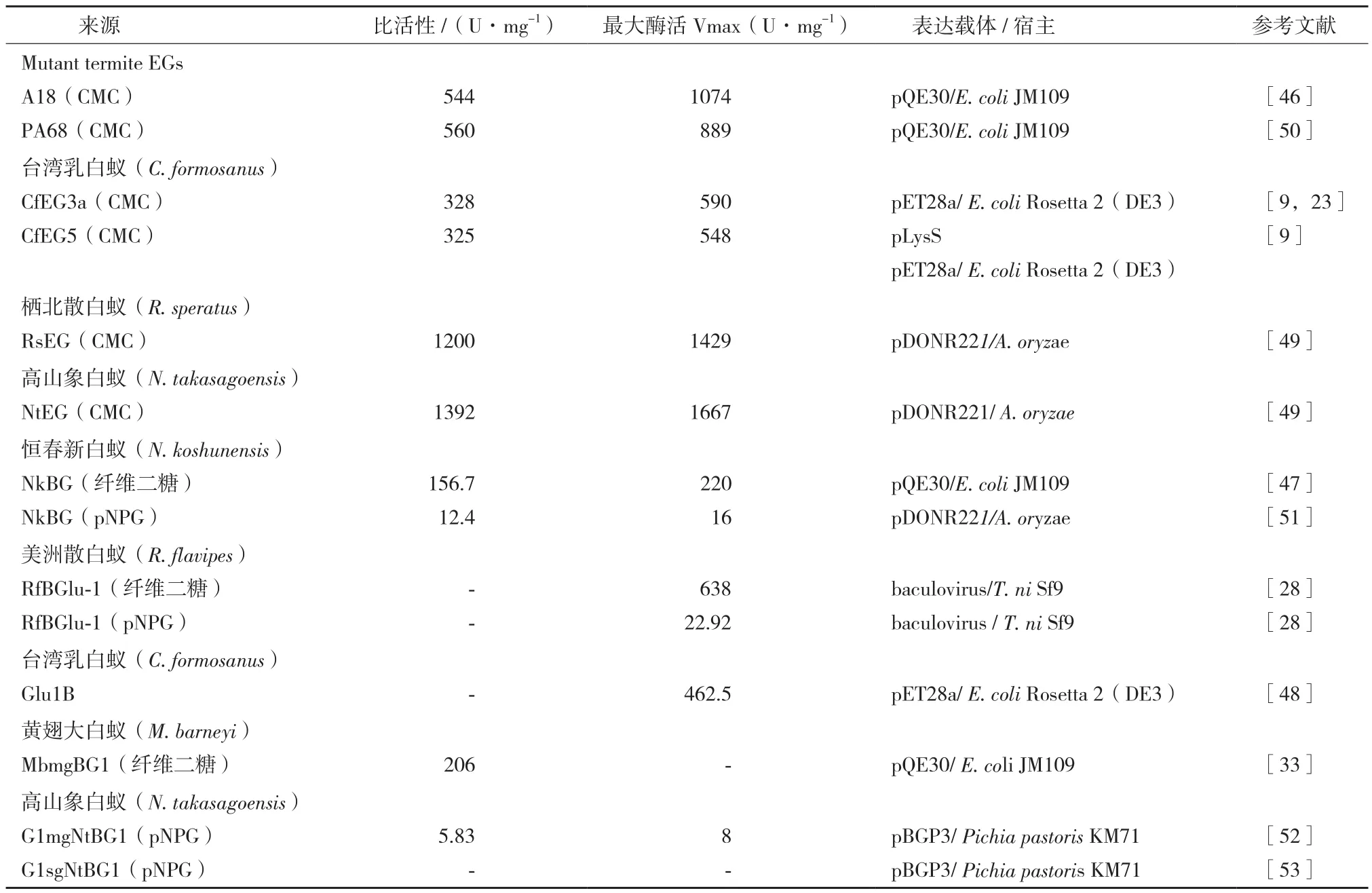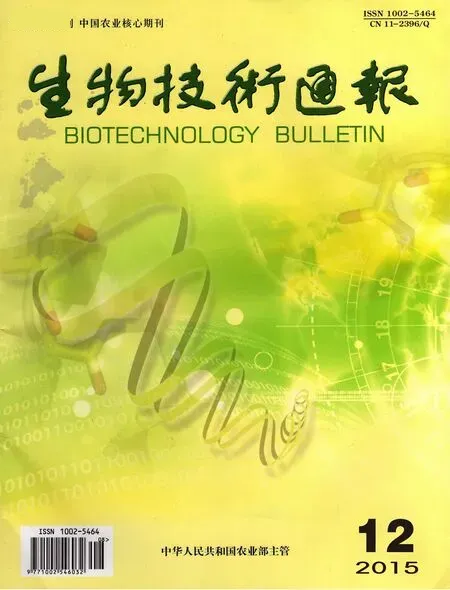白蟻內源性纖維素酶基因資源研究進展
劉小琳李志強張丹丹
(1. 中山大學昆蟲學研究所&有害生物控制與資源利用國家重點實驗室,廣州 510275;2. 廣東省昆蟲研究所 廣東省野生動物保護與利用公共實驗室 廣東省農業害蟲綜合治理重點實驗室,廣州 510260)
白蟻內源性纖維素酶基因資源研究進展
劉小琳1李志強2張丹丹1
(1. 中山大學昆蟲學研究所&有害生物控制與資源利用國家重點實驗室,廣州 510275;2. 廣東省昆蟲研究所 廣東省野生動物保護與利用公共實驗室 廣東省農業害蟲綜合治理重點實驗室,廣州 510260)
能源短缺是人類關注的焦點問題之一,而纖維素是自然界最為豐富的可再生資源。白蟻已進化出了獨特而高效的纖維素消化系統,具有豐富的纖維素酶及其基因資源,因而,近年來白蟻內源性纖維素消化體系的重要性被逐漸認識,不斷有內源性纖維素酶基因的研究報道。為了進一步推動有害白蟻控制新技術的研發,以及纖維素生物質新能源的應用探索,綜述了白蟻內源性纖維素酶基因克隆、表達等研究進展。
白蟻;內源性纖維素酶基因;基因克隆
纖維素是自然界中分布最廣、含量最豐富的一種可再生性生物資源,纖維素的利用與生物轉化對于解決目前世界能源危機以及糧食短缺、環境污染等問題具有十分重要的意義[1]。盡管許多微生物在纖維素類物質降解中起到了非常重要的作用,但降解緩慢,故目前纖維素的高效生物轉化仍存在諸多亟待解決的問題。一些植食性昆蟲與纖維素能源利用密切相關而受到關注,特別是木食性昆蟲(Xylophagous insects)能通過纖維素酶高效利用纖維素類物質,從中獲取足夠營養維持自身生長發育的需要[2,3],如食木蜚蠊、食木白蟻、天牛和木蜂等。其中,白蟻(蜚蠊目Blattodea:白蟻總科Termitoidae)是消化纖維素最有效的昆蟲類群,其降解效率可達74%-99%[4,5],而且每年消化的纖維素類物質總量巨大,被認為是地球上最小的高效生物反應器[6]。但是,白蟻被認為是完全依靠后腸共生微生物來完成纖維素的降解,白蟻具有內源性纖維素酶的觀點雖有報道卻長期受到質疑。直到1998年,棲北散白蟻(Reticulitermes speratus)唾液腺纖維素酶基因RsEG的克隆[7],人們才開始明確認識到白蟻內源性纖維素酶和共生微生物的外源性纖維素酶共同參與了纖維素的降解,內源性纖維素酶基因開始受到關注,特別是在白蟻中最大的類群白蟻科(Termitidae)[8]。白蟻高效利用纖維素的腸道生境條件和豐富的纖維素酶及其基因,為人類轉化和利用生物質能的研究提供了可借鑒的模型,在纖維素的生物能源轉化,以及環保型白蟻防治劑作用靶標的研究開發均具有重要意義[9]。為了推動相關研究的深入,本文對白蟻內源性纖維素酶基因克隆和表達等研究進展進行了綜述。
1 白蟻消化系統和內源性纖維素酶
基于低等白蟻腸道纖維素酶的分布,白蟻的雙重纖維素消化系統(Dual cellulose-digesting system)首次被Nakashima等[10]提出,即源自白蟻自身的內源纖維素酶的消化系統和基于后腸共生微生物產生的纖維素酶的消化系統。其后,有觀點認為白蟻的這兩個纖維素消化系統其實是統一的,兩者是連續發生并且共同作用[11,12],反對者認為該觀點的論據恰好是支持白蟻具有雙重纖維素消化系統[13]的觀點。白蟻纖維素消化應是內源性和共生微生物的纖維素酶協同作用,低等白蟻后腸的共生原生動物(厭氧鞭毛蟲)在吞噬、降解經白蟻破碎的木質纖維素顆粒發揮了重要作用[14],而為數眾多的高等白蟻則是內源性纖維素酶發揮了重要作用[6,15],當然在巢體內的共生真菌[16]和白蟻后腸的共生細菌[11]分泌的外源性纖維素酶亦參與了纖維素的有效降解,以維持白蟻自身和共生微生物的生長。
一般認為將纖維素分解為葡萄糖需要3類纖維素酶,包括外切-β-1,4-葡聚糖酶(exo-1,4-β-D-glucanase,CBH,EC 3.2.1.91)、內切-β-1,4-葡聚糖酶(endo-1,4-β-glucanase,EG,EC 3.2.1.4)和β-葡萄糖苷酶(β-1,4-D-glucosidase,BG,EC 3.2.1.21)[17]。白蟻內源性纖維素酶包括內切-β-1,4-葡聚糖酶(EG)和β-葡萄糖苷酶(BG),主要由白蟻的唾液腺和中腸分泌產生。內切-β-1,4-葡聚糖酶主要作用于纖維素分子內部的非結晶區,隨機水解β-1,4糖苷鍵,將長鏈纖維分子截斷,產生帶有非還原性末端的小分子纖維素和可溶性纖維寡聚糖;β-葡萄糖苷酶的主要作用是水解纖維二糖及低分子量的纖維寡糖生成葡萄糖。
2 白蟻內源性纖維素酶基因
白蟻內源性的EG酶cDNA全長測序顯示它們都存在一個催化結構域,并且這個結構域與其他動物的GHF9(糖基水解酶家族9)氨基酸序列的催化位點一致[10],這表明白蟻內源性的EG酶屬于GHF9,每種白蟻都包括個別來自GHF9的EG酶基因和GHF1家族的BG酶基因,而白蟻共生微生物存在多個EG酶、BG酶和CBH酶基因,遠大于白蟻的內源性纖維素酶基因。除了山林原白蟻(Hodotermopsis sjostedti)中腸的EST分析得到一個屬于GHF3的基因外,目前報道的白蟻內源性的BG酶均屬于GHF1[18]。美洲散白蟻(R. flavipes)的一內源性的EG酶基因經RNA干擾處理,白蟻甚至出現一定程度的死亡[19],說明內源性纖維素酶在白蟻消化甚至生長發育中起著不可或缺的作用。
棲北散白蟻內源性的內切葡聚糖酶活性的發現[20],特別是其編碼基因RsEG的克隆[7],使得白蟻自身能夠產生纖維素酶得到廣泛認可。根據美國國家生物技術信息中心的 GenBank數據,到目前為止已有4科18屬33種白蟻的內源性纖維素酶基因克隆得到了cDNA全長序列,其中從32種白蟻中得到了62個完整的內源性EG酶基因cDNA編碼序列,包括來自澳白蟻科和鼻白蟻科的6個低等白蟻種群,以及白蟻科的26個高等白蟻種群(表1),每個白蟻種群的內切葡聚糖酶基因存在多個基因拷貝。
首個被克隆的β-葡萄糖苷酶基因是從恒春新白蟻(Neotermes koshunensis)中克隆的NkBG[27]。相比較于內切葡聚糖酶基因的研究,β-葡萄糖苷酶基因的研究較少,目前有11種白蟻的β-葡萄糖苷酶基因被克隆,獲得了21個完整的內源性β-葡萄糖苷酶cDNA全長序列(表2)。
多個基因拷貝的維持與定位被認為能夠賦予原始基因新的功能、亞功能,同時保持每個基因拷貝功能的保守性[34]。白蟻的內源性纖維素酶基因也同時存在多個基因拷貝,這些同源基因組成一個基因家族,基因家族的成員彼此之間僅存在個別堿基的差異。雖然,白蟻內源性纖維素酶種內同源基因編碼的纖維素酶共同作用于纖維素的降解,但每個種內同源基因編碼的纖維素酶在纖維素的水解過程的功能意義仍有待研究。

表1 GenBank中收錄的白蟻EG酶基因cDNA全長序列

表2 GenBank中收錄的白蟻BG酶基因cDNA全長序列
3 白蟻內源性纖維素酶基因的體內表達
白蟻內源性纖維素酶基因的表達場所主要是唾液腺和中腸。低等白蟻內源性纖維素酶基因主要在唾液腺表達,高等白蟻內源性纖維素酶基因主要在中腸表皮表達,即白蟻內源性纖維素酶基因在進化過程中的體內表達位點從唾液腺發展至中腸,但是培菌性的高等白蟻黑翅土白蟻(Odontotermes formosanus)內源性EG酶主要在唾液腺表達[15],木食性的高等白蟻高山象白蟻(Nasutitermes takasagoensis)內源性BG酶在中腸和唾液腺均有明顯的表達[8,31]。
低等白蟻如格斯特乳白蟻(Coptotermes gestroi)、恒春新白蟻和棲北散白蟻等,其唾液腺和前腸的纖維素酶活力存在明顯的差異[35]。盡管前腸不是這些白蟻的分泌組織,但也存在較低的纖維素酶活力,這很有可能是在某種信號的誘導下,唾液腺表達分泌的纖維素酶隨唾液流入到前腸,這種信號分子包括誘食信息素[36,37]、抗生素[38]和蛋白類信息素[39]等。低等白蟻中腸纖維素酶可能由于中腸分泌的某些蛋白酶分解了一部分唾液腺分泌的纖維素酶,而導致較低的纖維素酶活力[40],而且在中腸內的分布也不均。
工業上應用于木質纖維素生物質能轉化最廣泛的里氏木霉菌(Trichoderma reesei)[41],是研究纖維素酶基因表達和分泌的模式系統。該系統存在多個表達調控因子,可對纖維素酶基因的表達進行連續的嚴謹控制[42,43],但由于里氏木霉菌分泌的纖維素酶較為單一,其中85%都屬于葡萄糖外切酶[44],而工業生物質能的轉化普遍需要混合酶系。因此,如果將白蟻內源性纖維素酶在里氏木霉菌中表達將可以填補該系統中缺乏的葡萄糖內切酶及糖苷酶成分。
4 白蟻纖維素酶基因的體外表達與活性
白蟻內源性纖維素酶在白蟻的纖維素降解過程中起著至關重要的作用,目前白蟻內源性纖維素酶基因在原核和真核宿主中已經成功實現超表達(表3)。2004年,Lee等[45]利用昆蟲桿狀病毒表達系統表達出了桑天牛高活性內切酶重組蛋白,是昆蟲纖維素酶第一次在體外表達有活性的蛋白。白蟻纖維素酶的外源表達開始很難實現,雖然通過剛果紅平板法檢測到高山象白蟻的NtEG基因的重組蛋白存在功能性表達[22],但首次在大腸桿菌(Escherichia coli)中實現超表達的白蟻纖維素酶基因的是4種白蟻[棲北散白蟻、高山象白蟻、臺灣乳白蟻和短刀乳白蟻(C. acinaciformis)]的內切酶基因突變體[46]。隨后,進行進一步的基因改組,又得到了PA68突變體酶,同樣在大腸桿菌中實現超表達[47]。近年來,多種白蟻纖維素酶基因在原核生物大腸桿菌中成功表達[9,23,33,48,49]。相較于原核生物表達系統,真核生物表達系統能夠表達更高活性的白蟻纖維素酶重組蛋白,棲北散白蟻的RsEG基因和高山象白蟻的NtEG基因在米曲霉(Aspergillus oryzae)中表達出高活性的纖維素酶重組蛋白,比活性分別高達1 200 U/mg和1 392 U/mg[50]。恒春新白蟻的NkEG基因也在米曲霉中成功表達出有活性的纖維素酶重組蛋白[51],白蟻纖維素酶基因在真菌中成功表達的還有畢赤酵母(Pichia pastoris)[52,53]。與此同時,美洲散白蟻的RfBGlu-1基因在粉紋夜蛾(Trichoplusis ni)的Sf9細胞(一種昆蟲表達系統的宿主細胞)中成功表達,并且以桿狀病毒作為載體,重組的白蟻纖維素酶基因最大活性高達638 U/mg[28]。

表3 白蟻內源性纖維素酶基因外源表達
5 結語
近一個世紀以來,白蟻對木質纖維素降解的高效性吸引了許多學者的注意,但長期以來人們普遍認為白蟻完全依賴共生微生物來降解纖維素。隨著新興的高通量檢測技術的發展,白蟻纖維素酶基因的相關研究得到了極大的關注,多種白蟻的內源性纖維素酶基因成功克隆,白蟻自身能夠產生纖維素酶得到證實。低等白蟻腸道內源性纖維素酶在分解纖維素中發揮重要作用[54],而木食性高等白蟻纖維素的降解對內源性纖維素酶的依賴程度更高[6,8,15,55]。當然高等白蟻后腸微生物在纖維素降解過程中也起著重要作用[56],同時高等白蟻后腸中的細菌群落的蛋白組學研究表明,相較于纖維素降解,后腸細菌產生的水解酶在新陳代謝(包括固氮作用、同化作用、異化作用和氨基酸的合成)中發揮更重要的作用[57]。最近的組學研究引起了關于白蟻生物學、生理學以及生物化學方面新信息的大爆炸,為生物技術進入新的既有的領域創造了空前的機會[57]。目前,只有兩種白蟻的全基因組已經測得,包括低等白蟻內華達動白蟻(Zootermopsis nevadensis)[58]和高等白蟻納塔爾大白蟻(Macrotermes natalensis)[59],這兩種白蟻全基因組信息為更多白蟻基因組的組裝提供了依據,以促進進化和生物過程相關基因的研究[60]。根據內華達動白蟻的全基因組序列分析,從中發現了大量與白蟻生長發育密切相關的基因[58]。在對格斯特乳白蟻轉錄組研究中發現新的內源性纖維素酶基因[61]。美洲散白蟻腸道宏轉錄組(Metatranscriptome)分析顯示,白蟻具有消化半纖維素和木質素的漆酶基因和過氧化酶基因[62]。除了基于基因組學和轉錄組學的研究之外,利用高分辨率固體核磁13C NMR技術從代謝組學的角度分析13C標記的纖維素在山林原白蟻腸道中的降解過程,證實了內源性纖維素酶在纖維素消化過程中的重要性,并且表明后腸細菌主要作用于纖維糊精或纖維二糖的磷酸解作用[63]。
運用新的生物技術發現更多的纖維素酶基因,并從中選取能夠在外源體系中表達高活性酶的基因,將能夠解決工業生產中纖維素酶體外表達活性弱,產量低等問題。盡管模仿白蟻消化系統的想法也存在已久,但將這一高效纖維素分解系統在工業應用仍有諸多問題亟待解決。目前,僅有少數白蟻內源性纖維素酶能夠在原核和真核生物表達系統中實現超表達。而對于生物質能的轉化,需要的纖維素酶能夠是低成本的大量表達,白蟻內源性纖維素酶在大腸桿菌中的表達大多只能得到少量的不可溶無水解酶活性的包涵體,目前在大腸桿菌能夠以活性狀態進行表達的白蟻內源性纖維素酶基因較少。因此,篩選體外高效表達并表達出活性狀態的重組蛋白的基因克隆,一方面有必要對纖維素酶本身蛋白質序列進行改造以適應原核表達系統,同時尋求能夠過度表達白蟻纖維素酶基因的真核表達系統,以實現白蟻內源性纖維素酶在工業生產上的應用。
[1] Carroll A, Somerville C. Cellulosic biofuels[J]. Annual Review of Plant Biology, 2009, 60(1):165-182.
[2] Watanabe H, Tokuda, G. Animal Cellulases[J]. Cellular and Molecular Life Science, 2001, 58(9):1167-1178.
[3] Watanabe H, Tokuda, G. Cellulolytic systems in insects[J]. Annual Review of Entomology, 2010, 55:609-632.
[4] Prins RA, Kreulen DA. Comparative aspects of plant cell wall digestion in insects[J]. Animal Feed Science and Technology,1991, 32(1-3):101-118.
[5] Breznak JA, Brune A. Role of microorganisms in the digestion of lignocellulose by termite[J]. Annual Review of Entomology, 1994,39:453-487.
[6] Ohkuma M. Termite symbiotic systems:efficient bio-recycling of lignocelluloses[J]. Applied Microbiology and Biotechnology,2003, 61(1):1-9.
[7] Watanabe H, Noda H, Nakamura M, et al. A cellulase gene of termite origin[J]. Nature, 1998, 394(6691):330-331.
[8] Tokuda G, Watanabe H, Hojo M, et al. Cellulolytic environment in themidgut of the wood-feeding higher termite Nasutitermes takasagoensis[J]. Journal of Insect Physiology, 2012, 58(1):147-154.
[9] Zhang D, Lax AR, Bland JM, et al. Characterization of a new endogenous endo-β-1, 4-glucanase of Formosan subterranean termite(Coptotermes formosanus)[J]. Insect Biochemistry and Molecular Biology, 2011, 41(4):211-218.
[10] Nakashima K, Watanabe H, Saitoh H, et al. Dual cellulosedigesting system of the wood-feeding termite, Coptotermes formosanus(Shiraki)[J]. Insect Biochemistry and Molecular Biology, 2002,32(7):777-784.
[11] Scharf ME, Karl ZJ, Sethi A, Boucias DG. Multiple levels of synergistic collaboration in termite lignocellulose digestion[J]. PLoS One, 2011, 6(7):e21709.
[12] Zhou X, Smith JA, Oi FM, et al. Correlation of cellulase gene expression and cellulolytic activity throughout the gut of the termite Reticulitermes flavipes[J]. Gene, 2007, 395(1-2):29-39.
[13] Tokuda G, Watanabe H, Lo N. Does correlation of cellulase gene expression and cellulolytic activity in the gut of termite suggest synergistic collaboration of cellulases?[J]. Gene, 2007, 401(1-2):131-134.
[14] Brune A, Friedrich M. Microecology of the termite gut:structure and function on a microscale[J]. Current Opinion in Microbiology, 2000, 3(3):263-269.
[15] Tokuda G, Lo N, Watanabe H, et al. Major alteration of the expression site of endogenous cellulases in members of an apical termite lineage[J]. Molecular Ecology, 2004, 13(10):3219-3228.
[16] Aanen DK, Eggleton P, Rouland-Lefèvré C, et al. The evolution of fungus-growing termites and their mutualistic fungal symbionts[J]. Proceedings of the National Academy of Sciences,2002, 99(23):14887-14892.
[17] 孫建中, 陳春潤. 昆蟲與生物質能源利用:一個新的交叉學科前沿[J]. 昆蟲知識, 2010, 47(6):1033-1042.
[18] Yuki M, Moriya S, Inoue T, et al. Transcriptome analysis of the digestive organs of Hodotermopsis sjostedti, a lower termite that hosts mutualistic microorganisms in its hindgut[J]. Zoological Science, 2008, 25(4):401-406.
[19] Zhou X, Wheeler MM, Oi FM, et al. RNA interference in the termite Reticulitermes flavipes through ingestion of double-stranded RNA[J]. Insect Biochemistry and Molecular Biology, 2008, 38(8):805-815.
[20] Watanabe H, Nakamura M, Tokuda G, et al. Site of secretion and properties of endogenous endo-β-1, 4-glucanase components from Reticulitermes speratus(Kolbe), a Japanese subterranean termite[J]. Insect Biochemistry and Molecular Biology, 1997, 27(4):305-313.
[21] Li L, Fr?hlich J, Pfeiffer P, et al. Termite gut symbiotic archaezoa are becoming living metabolic fossils[J]. Eukaryotic Cell, 2003,2(5):1091-1098.
[22] Tokuda G, Lo N, Watanabe H, et al. Metazoan cellulase genes from termites:intron/exon structures and sites of expression[J]. Biochimica et Biophysica Acta -Gene Structure and Expression,1999, 1447(2-3):146-159.
[23] Zhang D, Lax AR, Raina AK, et al. Differential cellulolytic activity of native-form and C-terminal tagged-form cellulase derived from Coptotermes formosanus and expressed in E. coli. [J]. Insect Biochemistry and Molecular Biology, 2009, 39(8):516-522.
[24] Cairo JP, Oliveira LC, Uchima CA, et al. Deciphering the synergism of endogenous glycoside hydrolase families 1 and 9 from Coptotermes gestroi[J]. Insect Biochemistry and Molecular Biology, 2013, 43(10):970-981.
[25] Scharf ME, Wu-Scharf D, Zhou X, et al. Gene expression profiles among immature and adult reproductive castes of the termite Reticulitermes flavipes[J]. Insect Molecular Biology, 2005, 14(1):31-44.
[26] Ni J, Wu Y, Yun C, et al. cDNA cloning and heterologous expression of an endo-β-1,4-glucanase from the fungus-growing termite Macrotermes barneyi[J]. Archives of Insect Biochemistry and Physiology, 2014, 86(3):151-164.
[27] Tokuda G, Saito H, Watanabe H. A digestiveb-glucosidase from the salivary glands of the termite, Neotermes koshunensis(Shiraki):distribution, characterization and isolation of its precursor cDNA by 5’- and 3’-RACE amplifications with degenerate primers[J]. Insect Biochemistry and Molecular Biology, 2002, 32(12):1681-1689.
[28] Scharf ME, Kovaleva ES, Jadhao S, et al. Functional and translational analyses of a beta-glucosidase gene(glycosyl hydrolase family 1)isolated from the gut of the lower termite Reticulitermes flavipes[J]. Insect Biochemistry and Molecular Biology, 2010, 40(8):611-620.
[29] Zhang D, Lax AR, Bland JM, et al. Hydrolysis of filter-paper cellulose to glucose by two recombinant endogenous glycosyl hydrolases of Coptotermes formosanus[J]. Insect Science, 2010,17(3):245-252.
[30] Zhang D, Lax AR, Henrissat B, et al. Carbohydrate-active enzymes revealed in Coptotermes formosanus(Isoptera:Rhinotermitidae)transcriptome[J]. Insect Molecular Biology, 2012a, 21(2):235-245.
[31] Tokuda G, Miyagi M, Makiya H, et al. Digestive beta-glucosidases from the wood-feeding higher termite, Nasutitermes takasagoensis:Intestinal distribution, molecular characterization, and alteration in sites of expression[J]. Insect Biochemistry and Molecular Biology, 2009, 39(12):931-937.
[32] Wu Y, Chi S, Yun C, et al. Molecular cloning and characterization of an endogenous digestive beta-glucosidase from the midgut of the fungus-growing termite Macrotermes barneyi[J]. InsectMolecular Biology, 2012, 21(6):604-614.
[33] Bujang NS, Harrison NA, Su NY. Molecular cloning of five betaglucosidases from four species of higher termites(Blattodea:Termitidae)[J]. Annals of the Entomological Society of America,2014, 107(1):251-256.
[34] Hahn MW. Distinguishing among evolutionary models for the maintenance of gene duplicates[J]. Journal of Heredity, 2009,100(5):605-617.
[35] Tokuda G, Lo N, Watanabe H. Marked variations in patterns of cellulase activity against crystalline- versus carboxymethylcellulose in the digestive systems of diverse, wood-feeding termites[J]. Physiological Entomology, 2005, 30(4):372-380.
[36] Reinhard J, Kaib M. Food exploitation in termites:indication for a general feeding stimulating signal in labial gland secretion of Isoptera[J]. Journal of Chemical Ecology, 2001a, 27(1):189-201.
[37] Reinhard J, Kaib M. Thin-layer chromatography assessing feeding stimulation by labial gland secretion compared to synthetic chemicals in the subterranean termite Reticulitermes santonensis[J]. Journal of Chemical Ecology, 2001b, 27(1):175-187.
[38] Lamberty M, Zachary D, Lanot R, et al. Insect immunity:Constitutive expression of a cysteine-rich antifungal and a linear antibacterial peptide in a termite insect[J]. Journal of Biological Chemistry, 2001, 276(6):4085-4092.
[39] Matsuura K, Yashiro T, Shimizu K, et al. Cuckoo fungus mimics termite eggs by producing the cellulose-digesting enzyme β-glucosidase[J]. Current Biology, 2009, 19(1):30-36.
[40] Fujita A, Shimizu I, Abe T. Distribution of lysozyme and protease,and amino acid concentration in the guts of a wood-feeding termite, Reticulitermes speratus(Kolbe):possible digestion of symbiont bacteria transferred by trophallaxis[J]. Physiological Entomology, 2001, 26(2):116-123.
[41] Xu Q, Singh A, Himmel ME. Perspectives and new directions for the productionof bioethanol using consolidated bioprocessing of lignocellulose[J]. CurrentOpinion in Biotechnology, 2009, 20(3):364-371.
[42] Seiboth B, Karimi RA, Phatale PA, et al. The putative protein methyltransferase LAE1 controlscellulase gene expression in Trichoderma reeseimmi[J]. Molecular Microbiology, 2012, 84(6):1150-1164.
[43] Portnoy T, Margeot A, Linke R, et al. The CRE1 carbon catabolite repressor of thefungus Trichoderma reesei:a master regulator of carbon assimilation[J]. BMC Genomics, 2011, 12:269.
[44] Zou G, Shi S, Jiang Y, et al. Construction of a cellulase hyperexpressionsystem in Trichoderma reesei by promoter andenzyme engineering[J]. Microbial Cell Factories, 2012, 11:21.
[45] Lee SJ, Kim SR, Yoon HJ, et al. cDNA cloning, expression, and enzymatic activity of a cellulase from the mulberry longicorn beetle,Apriona germari[J]. Comparative Biochemistry and Physiology Part B:Biochemistry and Molecular Biology, 2004, 139(1):107-116.
[46] Ni J, Takehara M, Watanabe H. Heterologous overexpression of a mutant termite cellulose gene in Escherichia coli by DNA shuffling of four orthologous parental cDNAs[J]. Bioscience,Biotechnology, and Biochemistry, 2005, 69(9):1711-1720.
[47] Ni J, Tokuda G, Takehara M, et al. Heterologous expression and enzymatic characterization of β-glucosidase from the dry woodeating termite, Neotermes koshunensis[J]. Applied Entomology and Zoology, 2007b, 42(3):457-463.
[48] Zhang D, Allen AB, Lax AR. Functional analyses of the digestive β-glucosidase of Formosan subterranean termites(Coptotermes formosanus)[J]. Journal of Insect Physiology, 2012b, 58(1):205-210.
[49] Hirayama K, Watanabe H, Tokuda G, et al. Purification and characterization of termite endogenous β-1, 4-endoglucanases produced in Aspergillus oryzae[J]. Bioscience, Biotechnology,and Biochemistry, 2010, 74(8):1680-1686.
[50] Ni J, Takehara M, Miyazawa M, et al. Random exchanges of non-conserved amino acid residues among four parental termite cellulases by family shuffling improved thermostability[J]. Protein Engineering, Design and Selection, 2007a, 20(11):535-542.
[51] Uchima CA, Tokuda G, Watanabe H, et al. Heterologous expression and characterization of a glucose-stimulated β-glucosidase from the termite Neotermes koshunensis in Aspergillus oryzae[J]. Applied Microbiology and Biotechnology, 2011, 89(6):1761-1771.
[52] Uchima CA, Tokuda G, Watanabe H, et al. Heterologous expression in Pichia pastoris and characterization of an endogenous thermostable and high glucose-tolerant β-glucosidase fromthe termite Nasutitermes takasagoensis[J]. Applied and Environmental Microbiology, 2012, 78(12):4288-4293.
[53] Uchima CA, Tokuda G, Watanabe H, et al. A novel glucose-tolerant β-glucosidase from the salivary gland of the termite Nasutitermes takasagoensis[J]. The Journal of General and Applied Microbiology, 2013, 59(2):141-145.
[54] Watanabe H, Nakashima K, Saito H, et al. New endo-β-1, 4-glucanases from the parabasalian symbionts, Pseudotrichonympha grassii and Holomastigotoides mirabile of Coptotermes termites[J]. Cellular and Molecular Life Science, 2002, 59(11):1983-1992.
[55] Tokuda G, Watanabe H, Matsumoto T, et al. Cellulose digestion in the wood-eating higher termite, Nasutitermes takasagoensis(Shiraki):distribution of cellulases and properties of endo-beta-1,4-glucanase[J]. Zoological Science, 1997, 14(1):83-93.
[56] Warnecke F, Luginbuhl P, Ivanova N, et al. Metagenomic and functional analysis of hindgut microbiota of a wood-feeding higher termite[J]. Nature, 2007, 450(7169):560-565.
[57] Burnum KE, Callister SJ, Nicora CD, et al. Proteome insights into the symbiotic relationship between a captive colony of Nasutitermes corniger and its hindgut microbiome[J]. The ISME Journal,2011, 5(1):161-164.
[58] Terrapon N, Li C, Robertson HM, et al. Molecular traces of alternative social organizationin a termite genome[J]. Nature Communications, 2014, 5:3636.
[59] Poulsen M, Hu H, Li C, et al. Complementary symbiont contributions to plant decomposition in a fungus-farming termite[J]. Proceedings of the National Academy of Sciences, 2014, 111(40):14500-14505.
[60] Scharf ME. Omic research in termites:an overview and aroadmap[J]. Frontiers in Genetics, 2015, 6:76.
[61] Leonardo FC, da Cunha AF, da Silva MJ, et al. Analysis of the workers headtranscriptome of the Asian subterraneantermite,Coptotermes gestroi[J]. Bulletin of Entomological Research,2011, 101(4):383-391.
[62] Tartar A, Wheeler MM, Zhou XG, et al. Parallel metatranscriptome analyses of host and symbiont gene expression in the gut of the termite Reticulitermes flavipes[J]. Biotechnology for Biofuels,2009, 2:25.
[63] Tokuda G, Tsuboi Y, Kihara K, et al. Metabolomic profiling of13C-labelled cellulose digestion in a lower termite:insights into gut symbiont function[J]. Proceeding B of the Royal Society, 2014,281:20140990.
(責任編輯 狄艷紅)
Research Advances on Endogenous Cellulase Gene Resources of Termites
Liu Xiaolin1Li Zhiqiang2Zhang Dandan1
(1. Institute of Entomology and State Key Laboratory of Biocontrol,Sun Yat-sen University,Guangzhou 510275;2. Guangdong Entomological Institute,Guangdong Public Laboratory of Wild Animal Conservation and Utilization,Guangdong Key Laboratory of Integrated Pest Management in Agriculture,Guangzhou 510260)
Energy shortage has become a global problem, and cellulose is the most abundant and renewable resource in nature. Termites have evolved the unique and efficient cellulose-digesting system, in which there are rich resources of cellulase and its genes. In recent years, the significance of endogenous cellulose-digesting system in termite has been recognized gradually, and the researches on the endogenous cellulase genes have been reported continuously. In order to improve the new control technologies of termite pests and to explore the cellulosic biomass for biofuels, the review provides the information for the cloning and expressions of termite endogenous cellulase genes.
termite;endogenous cellulase gene;gene cloning
10.13560/j.cnki.biotech.bull.1985.2015.12.004
2015-04-01
國家自然科學基金項目(31172163),廣東省昆蟲研究所創新人才基金項目(GDEI-cxrc201302)
劉小琳,女,碩士研究生,研究方向:昆蟲分子生物學;E-mail:liuxiaolin.1222@163.com
張丹丹,女,副教授,研究方向:昆蟲分類與系統分化;E-mail:zhangdd6@mail.sysu.edu.cn

